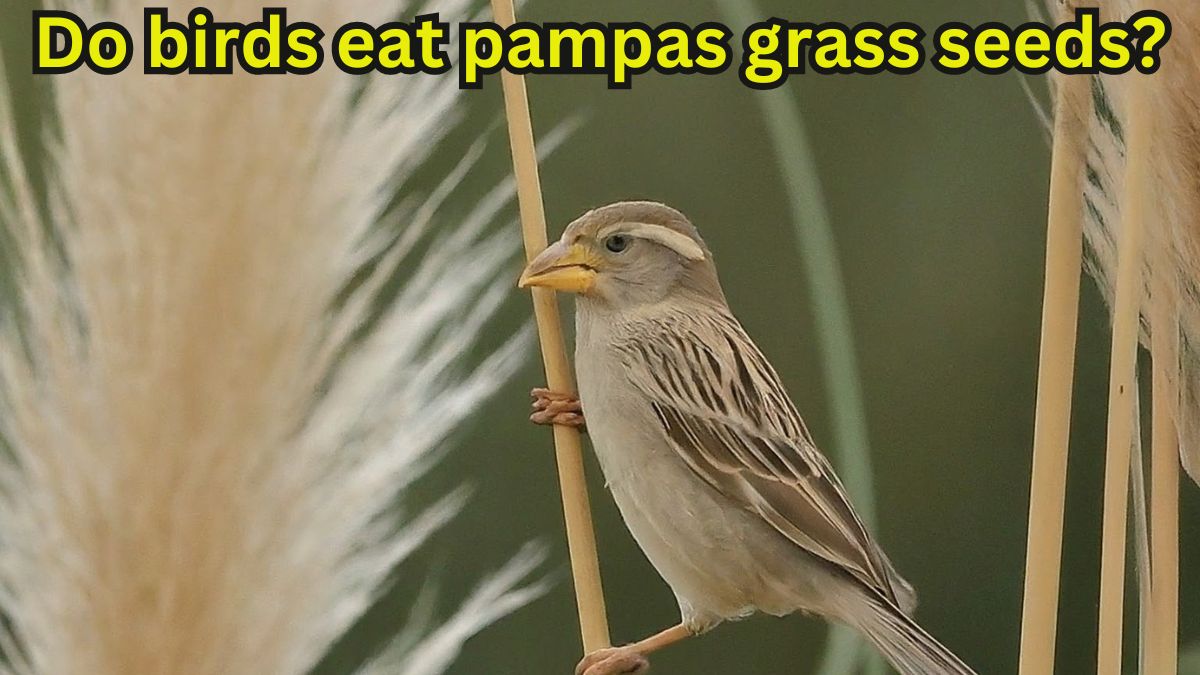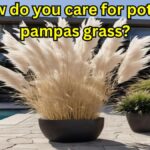Have you ever wondered Do birds eat pampas grass seeds? In this blog post, we’re going to find out. We’ll look at what birds eat and how they interact with pampas grass. We’ll also talk about how birds help spread seeds around. So, if you’re curious about birds, pampas grass, or both, keep reading!
The Relationship Between Birds and Pampas Grass
Pampas Grass and Its Seed Production
Pampas grass, scientifically known as Cortaderia selloana, is a beautiful ornamental grass native to South America. It’s known for its lush white or pink plumes that sit atop each stem. These plumes are actually clusters of flowers, and each flower can produce thousands of seeds. The seeds are small, fluffy, and typically tan or beige in color. They are produced at the end of the growing season, and strong winds can carry these seeds over long distances. This grass is quite resilient and can germinate in a variety of climate conditions and almost any soil mixture.
Bird Species That Might Interact with Pampas Grass
The interaction between birds and pampas grass is a fascinating aspect of nature. Birds, especially those native to the Pampas region of South America, might interact with pampas grass in various ways. For instance, the Pampas Meadowlark, a bird species found in the Pampas region, could potentially interact with pampas grass. However, the specific interaction between birds and pampas grass, particularly regarding seed consumption, may vary depending on the bird species and other environmental factors.
Do Birds Eat Pampas Grass Seeds?
The relationship between birds and pampas grass seeds is quite interesting. While it’s common to see birds in areas where pampas grass grows, the question of whether they actually consume these seeds is not as straightforward as it might seem.
Pampas grass, known for its beautiful plumes, produces thousands of seeds each season. These seeds are small, fluffy, and easily carried by the wind. But do birds eat them?
Some sources suggest that birds, especially those that feed on seeds, might be attracted to pampas grass seeds. However, it’s important to note that not all birds that interact with pampas grass are necessarily eating the seeds. Some birds may scratch the ground for insects, inadvertently exposing the seeds. These exposed seeds might not germinate properly, leading to the misconception that birds are eating the seeds.
On the other hand, some ground-feeding songbirds and gamebirds have been observed eating fallen seeds from grasses. This suggests that some bird species might indeed consume pampas grass seeds if they come across them.
Can you cut pampas grass to the ground?
Nutritional Value of Pampas Grass Seeds for Birds
Nutritional Content of Pampas Grass Seeds
Pampas grass seeds, like many other grass seeds, are believed to contain a variety of nutrients. However, specific nutritional information about pampas grass seeds is not readily available. Generally, grass seeds are known to be rich in carbohydrates and fiber, and they may also contain some protein and fat. They can also contain trace amounts of vitamins and minerals.
Benefits for Bird Species That Consume Them
While the nutritional content of pampas grass seeds may not be fully understood, it’s clear that seeds play a crucial role in the diets of many bird species. Seeds provide birds with the energy they need to fly, maintain body temperature, and carry out other vital functions. The fiber in seeds aids in digestion, while the protein supports growth and repair.
However, it’s important to note that not all birds may be able to digest and extract nutrients from all types of seeds. The ability to do so depends on the bird species and its specific dietary adaptations.
Moreover, pampas grass seeds may offer benefits beyond nutrition. The large plumes of pampas grass provide shelter and nesting sites for birds, contributing to the biodiversity of the garden and supporting local wildlife.
Impact of Birds on Pampas Grass
Birds play a significant role in the life cycle of Pampas Grass. Here’s how:
Impact of Birds on Pampas Grass:Birds contribute to the biodiversity of the Pampas ecosystem. They find safety and protection within the dense foliage of Pampas Grass, as well as a place to build their nests and raise their young. However, Pampas Grass has leaf blades that are highly undesirable as food or shelter to birds and other wildlife, and can actually cause physical harm to those animals, including humans, because the leaves are extremely sharp.
Role of Birds in Seed Dispersal: Birds play a crucial role in the propagation and regrowth of plant species through seed dispersal. They transport undigested seeds in their digestive tract and then disperse them through their feces, resulting in seed germination and growth in new locations. This process allows plants to colonize new areas, ensuring their survival and genetic diversity. Pampas Grass spreads by producing seeds and rhizomes, allowing it to grow in different environments. Its feathery plumes help the seeds travel through wind, animals, and water, expanding its presence far and wide.
Effect of Bird Feeding Habits on the Growth and Spread of Pampas Grass: Birds’ feeding habits can influence the spread of Pampas Grass. When birds consume the seeds of Pampas Grass, they can transport these seeds over large distances before excreting them. This can lead to the establishment of new Pampas Grass colonies in locations far from the original plant. However, if there are no open sources of food or birdseed nearby, there shouldn’t be too much of a problem with anything slithering into your Pampas Grass.
Managing Birds and Pampas Grass in Gardens
Managing birds and Pampas Grass in your garden can be a delicate balance, but with the right strategies, you can create a bird-friendly environment while also ensuring healthy growth of your Pampas Grass. Here are some tips:
Managing Birds Eating Pampas Grass Seeds
- Cover the Seeded Area: Use a lightweight, breathable fabric or bird netting to cover the seeded area. This creates a physical barrier between the birds and the seed, making it more difficult for them to access.
- Noise Deterrents: Birds are easily frightened by loud, sudden noises. Devices that emit loud, high-pitched sounds mimicking the distress calls of birds in danger can be used to startle birds and make them think there is a predator nearby.
- Reflective Objects: Shiny, reflective objects like foil balloons can deter birds. The movement and reflection of light from these objects can scare away birds.
- Decoys: Fake predators or scarecrows can be used to frighten the birds.
Balancing a Bird-Friendly Garden with Healthy Pampas Grass Growth
- Planting Location: Plant your Pampas Grass in a location that is not too close to bird feeders or popular bird hangout spots. This can help reduce the likelihood of birds eating the seeds.
- Regular Maintenance: Regularly prune your Pampas Grass to maintain its health and vigor. Remove dead or diseased leaves and stems to maintain a tidy appearance.
- Watering and Fertilizing: Water your Pampas Grass deeply and regularly, especially during dry spells. Apply a balanced fertilizer in spring and fall to support healthy growth and abundant blooms.
- Bird Feeders: If you want to attract birds to your garden, consider setting up bird feeders filled with birdseed or other foods that birds prefer over Pampas Grass seeds.
Ecological Perspectives
Ecological Implications of Birds Interacting with Pampas Grass
Birds interacting with Pampas Grass can have several ecological implications. Birds contribute to the biodiversity of the Pampas ecosystem. They use the habitat provided by roadsides, which often include Pampas Grass, for foraging and performing reproduction-related behaviors. However, the sharp leaves of Pampas Grass can cause physical harm to birds.
Birds also play a crucial role in seed dispersal, which is vital for the propagation and regrowth of plant species like Pampas Grass. When birds consume the seeds of Pampas Grass, they can transport these seeds over large distances before excreting them. This can lead to the establishment of new Pampas Grass colonies in locations far from the original plant.
Importance of Preserving Both Plant and Bird Species in Garden Ecosystems
Preserving both plant and bird species in garden ecosystems is crucial for maintaining biodiversity. Biodiversity helps protect our food supply, prevent disease, and save money. Birds play a crucial role in maintaining a balanced ecosystem. They help to control insect populations, pollinate plants, disperse seeds, and recycle nutrients back into the soil.
Native plants are the ecological basis upon which life depends, including birds and people. Without them and the insects that co-evolved with them, local birds cannot survive. For example, native oak trees support over 500 species of caterpillars whereas ginkgos, a commonly planted landscape tree from Asia, host only 5 species of caterpillars.
In addition to being good indicators of biodiversity change in response to landscape modifications, birds and plants may complement each other in supplying ecosystem services. Therefore, homeowners, landscapers, and local policy makers can benefit birds and other wildlife by simply selecting native plants when making their landscaping decisions.
Conclusion
In conclusion, birds do interact with Pampas Grass, but their relationship is complex and multifaceted. While birds can contribute to the spread of Pampas Grass through seed dispersal, the plant’s sharp leaves make it a less desirable habitat for birds. Therefore, while birds may occasionally consume Pampas Grass seeds, it is not a significant part of their diet. Gardeners can manage this interaction through careful planning and maintenance, ensuring a balance between a bird-friendly garden and healthy Pampas Grass growth. Understanding these dynamics is crucial for maintaining biodiversity and ensuring the health of our garden ecosystems.
FAQs
Here are some FAQs :
- Do birds prefer Pampas Grass seeds over other types of seeds? Birds are attracted to a variety of seeds, and their preferences can vary. While grass seed isn’t nearly as nutritious as sunflower seed (which is just one of many types of seeds birds feed on), it’s easy to pick. Pampas grass seeds may be consumed by birds due to their availability. However, it seems that wild birds may opt for your grass seed if you’re regrowing your lawn simply because of its availability.
- What impact does the consumption of Pampas Grass seeds have on bird health? I couldn’t find specific information on the impact of Pampas Grass seeds on bird health. However, it’s worth noting that a varied diet, including different types of seeds, can contribute to the overall health of birds.
- How does bird consumption of Pampas Grass seeds affect the spread of this plant? Pampas grass spreads primarily by seed. When birds consume these seeds, they can potentially disperse them over large areas through their droppings, contributing to the spread of this plant. This can lead to Pampas grass becoming an invasive species in some areas, as it can outcompete native plant species and disrupt ecosystems.


